Partners in Disaster
(Ed. note: The following article by David Kotok, Chairman and Chief Investment Officer, Cumberland Advisors and Bob Bunting, Climate Adaptation Center CEO, was published by Cumberland Advisors in the company’s Market Commentary newsletter in the aftermath of Hurricane Idalia. It has been lightly edited for publication here.)
Hurricane Idalia—an unfinished catastrophe
The following image was posted by the Sarasota, Florida Police Department during Hurricane Idalia.
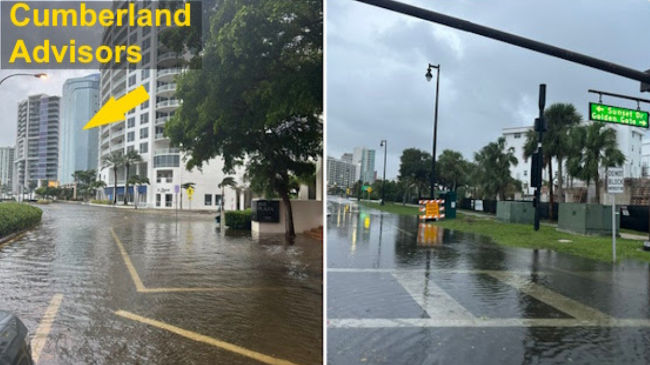
Hurricane Idalia causing flooding near Sarasota’s Bayfront and Downtown area (Photo credit, Cynthia McLaughlin, Sarasota PD).
From David Kotok:
At the time of the image above, flooded roads included ones surrounding Cumberland Advisors’ Sarasota office and evacuation routes for the nearby barrier islands.
Farther north on the Gulf Coast and up to the Big Bend area, there are folks who are totally wiped out. The Idalia storm hit Category 4, 130 mph wind speed at one point. The peak storm surge reached the mid-teens in feet. Florida has another multi-billion-dollar “catastrophe” to deal with. Meanwhile, the cleanup and fix-up after last year’s Hurricane Ian is not finished. There are people still living under tarps in the inland flooding areas. One permanent resident of Sanibel tells me that the recovery is about 20% so far. And, of course, there were budget cuts in the most recent Florida state budget. Those cuts included many millions pertaining to the “flood zones” and flood- or water-damage mitigation. All while the insurance situation in Florida worsens – and this Idalia outcome will only exacerbate the failing insurance policies of state government in Florida. More insurance companies will pull out of Florida. Many won’t write coverage here.
Politicians like to blame the insurance companies. Of course—that is much easier than blaming themselves. One cannot expect insurance companies to go on writing policies that will result in losses. You wouldn’t. I wouldn’t. Why should an insurance company do something irrational?
Now let me get to the bigger issue.
The oceans and seas are getting hotter worldwide. The reason is global warming. The impact we see in fires and smoke and heat domes is even more accentuated where we don’t see it, in our oceans and seas. Will this Idalia be enough to precipitate a major policy change? I doubt it. Will heat dome emergency medical cases and excess deaths in the Southwest United States be enough? Not yet.
My personal fear is that it will take large and repeated catastrophes with many dead and trillions in property destroyed before the wake-up call works and our political leaders either get thrown out of office or change from fighting political culture wars to addressing the common goal of America’s safety and need for climate change mitigation.
In my opinion, we’re not there yet. It will take some more pain to make people realize they must demand action from leaders, not finger-pointing blame. On Sunday, we wrote about some of the issues that are in sharper focus in the storm’s wake in Cumberland Advisors’ Market Commentary newsletter: “Idalia heads for Florida. Is Florida ready?”
We offer best wishes to the victims of Idalia, the latest in an unfinished series of “catastrophes.”
More are coming.
After the Hurricane Idalia news became serious, I asked Bob Bunting about the marine heat wave effects. Note that there is also one along the US West Coast, from Baja north to Oregon. Bob was kind enough to offer the note below as a guest commentary about hotter water in oceans and seas. I am a longtime supporter of the Climate Adaptation Center, which he founded and runs. Also, please note that Cumberland uses ESG (Environmental, Social, and Governance) factors as part of the credit evaluation of municipal bond risk and in certain asset management techniques.
We thank Bob Bunting for again helping clarify the situation with facts.
What’s a Marine Heatwave, and Why Should You Care?
Bob Bunting:
Marine heatwaves (MHWs) have now emerged as a big climate topic, although this may be a new term for you. Do you remember an event in the news called “The Blob”? Beginning in late 2014 and continuing into 2016, the MHW began off the coast of Alaska, and then super-warm water expanded into a long-lasting event that disrupted weather patterns and caused disruptions in the fisheries in a much wider area, as shown in Figure 1, below. The Blob is the longest-running MHW ever recorded.
The color codes indicate temperature deviation from the average, in °C. The dark purple area was at least 3°C (about 6°F) warmer than normal, for a long time.
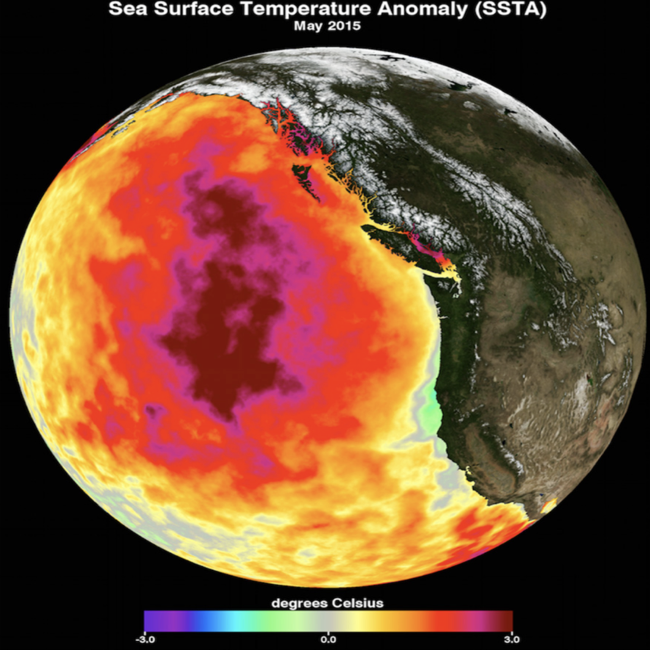
Figure 1: The longest-running MHW to date was called The Blob, 2014–2016
What are MHWs?
One of the most common ways that scientists record the ocean’s temperature is through sea surface temperature (SST). Marine heatwaves are long periods, months or longer, of very high SSTs, at least 2–3°C above normal. When temperatures deviate from a long-term average, we call them anomalies. In the earth-atmosphere system, anything anomaly greater than 1°C is quite significant when talking about monthly, yearly, or longer periods in the air or the sea.
MHW Impacts
Using “The Blob” as an example, let me highlight the specific impact related to fisheries. The image below shows the marine organisms that were winners and losers in this event. Each new event has a different lineup of winners and losers, as discussed later in this article.
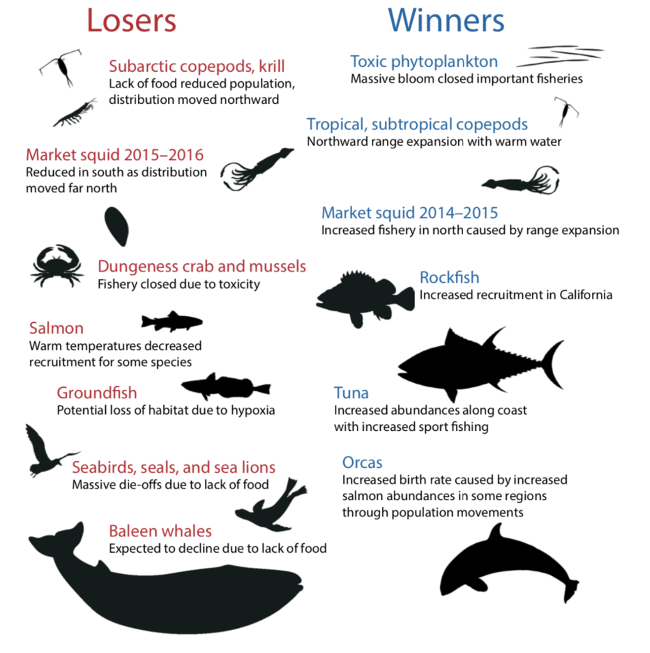
Figure 2: Organisms positively and negatively impacted by the “Blob” MHW. Negatively affected organisms are labeled “losers,” while those positively affected are “winners.” Although not shown in this chart, Anchovies turned out to be the biggest winners. Credit: Cavole et al (2016)
MHWs are becoming more frequent
MHWs are on the increase in both number and intensity because the global climate is warming at an alarming rate. Figure 3 shows the global average number of MHW events from 1982 through 2016. (For example, in 1985 roughly two MHWs per region, averaged over all regions of the global ocean.)
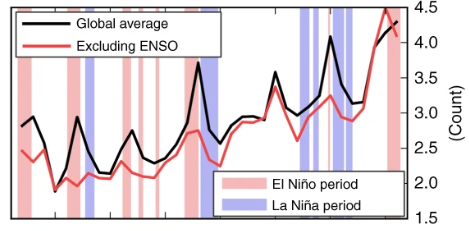 Figure 3: The frequency of MHW events is increasing rapidly. Source: Oliver et al (2018)
Figure 3: The frequency of MHW events is increasing rapidly. Source: Oliver et al (2018)
In fact, the rate of climate warming has doubled since 1990, and the number of extreme weather events is increasing as a result. There are more tropical storms and hurricanes, and they are more intense and longer-lasting. There are also longer-lasting algae blooms, including red tide, blue-green algae, and sargassum, in response to the increased energy in the earth-atmospheric system. The Climate Adaptation Center is dedicated to bringing clarity and trustworthy information about these impacts, so that we all can make better, faster, and more financially sound decisions, no matter what roles we play in life, whether individuals, business managers, government leaders, philanthropists, or educators. We all wear different hats, so think about your role and how the CAC can help your own decision making in our high-risk world, where climate-change is accelerating.
The oceans and seas absorb 90% of the excess energy created by human-caused emissions of greenhouse gases like CO2 and methane. The GHGs going into the atmosphere from eight billion humans using more fossil fuels, growing more food with CO2-producing inputs, and wasting 40% of all the food grown (which is thrown away and often rots in landfills, creating more methane) are rapidly changing the natural balance, and the global system is responding by heating rapidly. The oceans are massive reservoirs that warm slowly but with a great impact on atmospheric and marine systems. That is why MHWs are on the rise and becoming more severe, with increasing economic impacts.
As you read this, there is a major MHW in the Gulf of Mexico that is bleaching and killing Florida’s Coral Reef, the second largest coral reef in the world. When the reef dies off, biodiversity does, too, and that die-off impacts fisheries and the abundance of food we take from the sea. It takes a rise of only 1°C in sea temperatures above the long-term normal to create coral mortality and a crisis of biodiversity.
The following NOAA image shows the sad impact of the ongoing Gulf of Mexico MHW on Florida’s Coral Reef.
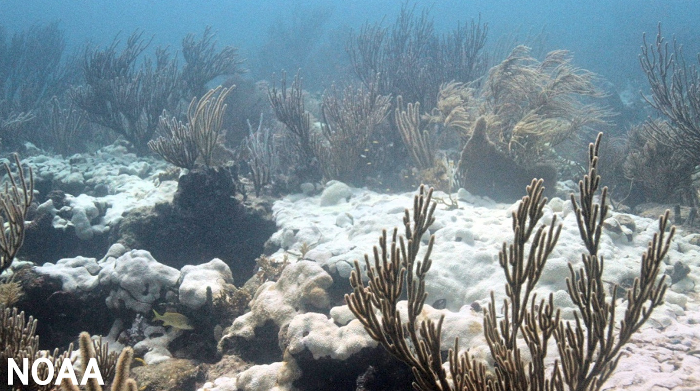
Florida reef coral bleaching. Image: NOAA
Why should we care?
To make matters worse, Florida’s MHW is happening during peak hurricane season. The Gulf is usually warm, but record-breaking ocean temperatures are setting up the conditions for super hurricanes.
Six such events have impacted the Gulf Coast since 2017, costing $425 billion in damages. Two Category 5s have devastated Florida since 2018 alone, causing over $130 billion in damages and the loss of 100 lives. Consequently, insurance premiums are though the roof… the roofs that didn’t blow away, that is! Louisiana has suffered seven such hits since 2020; and Texas endured the greatest financial loss in hurricane history in 2017, when Hurricane Harvey caused $150 billion in damages.
What will 2023 bring? Another active year is ongoing, and a storm called Idalia is going to turn heads. We have a long way to go in 2023, which is likely to be the warmest year on record. The financial and economic impacts of climate change and MHWs are not well understood, reported, or considered; but like it or not, they will happen, and soon! Oceans are heating and MHWs are more frequent—the impacts on superstorms, algae blooms, biodiversity, fisheries, ocean circulation, and melting ice are just the tip of the proverbial (melting) iceberg. The financial and economic implications are momentous.
For more information about today’s warming oceans and marine heatwaves, read this piece in Wired: “An Ominous Heating Event Is Unfolding in the Oceans”
If you’d like to receive updates and alerts from the Climate Adaptation Center, click on the “Subscribe” button below.

